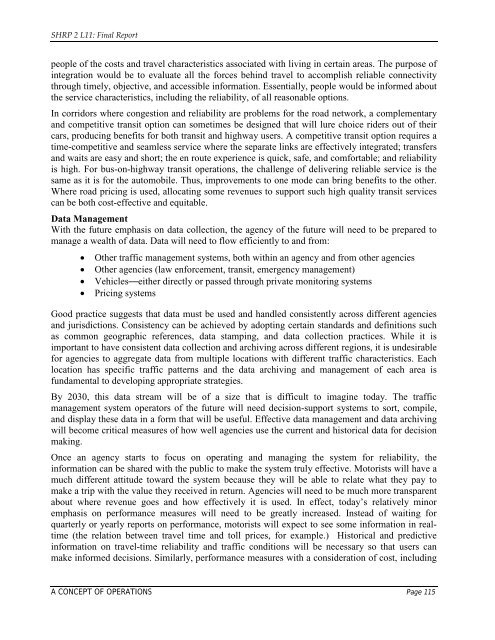Evaluating Alternative Operations Strategies to Improve Travel Time ...
Evaluating Alternative Operations Strategies to Improve Travel Time ...
Evaluating Alternative Operations Strategies to Improve Travel Time ...
Create successful ePaper yourself
Turn your PDF publications into a flip-book with our unique Google optimized e-Paper software.
SHRP 2 L11: Final Report<br />
people of the costs and travel characteristics associated with living in certain areas. The purpose of<br />
integration would be <strong>to</strong> evaluate all the forces behind travel <strong>to</strong> accomplish reliable connectivity<br />
through timely, objective, and accessible information. Essentially, people would be informed about<br />
the service characteristics, including the reliability, of all reasonable options.<br />
In corridors where congestion and reliability are problems for the road network, a complementary<br />
and competitive transit option can sometimes be designed that will lure choice riders out of their<br />
cars, producing benefits for both transit and highway users. A competitive transit option requires a<br />
time-competitive and seamless service where the separate links are effectively integrated; transfers<br />
and waits are easy and short; the en route experience is quick, safe, and comfortable; and reliability<br />
is high. For bus-on-highway transit operations, the challenge of delivering reliable service is the<br />
same as it is for the au<strong>to</strong>mobile. Thus, improvements <strong>to</strong> one mode can bring benefits <strong>to</strong> the other.<br />
Where road pricing is used, allocating some revenues <strong>to</strong> support such high quality transit services<br />
can be both cost-effective and equitable.<br />
Data Management<br />
With the future emphasis on data collection, the agency of the future will need <strong>to</strong> be prepared <strong>to</strong><br />
manage a wealth of data. Data will need <strong>to</strong> flow efficiently <strong>to</strong> and from:<br />
• Other traffic management systems, both within an agency and from other agencies<br />
• Other agencies (law enforcement, transit, emergency management)<br />
• Vehicles—either directly or passed through private moni<strong>to</strong>ring systems<br />
• Pricing systems<br />
Good practice suggests that data must be used and handled consistently across different agencies<br />
and jurisdictions. Consistency can be achieved by adopting certain standards and definitions such<br />
as common geographic references, data stamping, and data collection practices. While it is<br />
important <strong>to</strong> have consistent data collection and archiving across different regions, it is undesirable<br />
for agencies <strong>to</strong> aggregate data from multiple locations with different traffic characteristics. Each<br />
location has specific traffic patterns and the data archiving and management of each area is<br />
fundamental <strong>to</strong> developing appropriate strategies.<br />
By 2030, this data stream will be of a size that is difficult <strong>to</strong> imagine <strong>to</strong>day. The traffic<br />
management system opera<strong>to</strong>rs of the future will need decision-support systems <strong>to</strong> sort, compile,<br />
and display these data in a form that will be useful. Effective data management and data archiving<br />
will become critical measures of how well agencies use the current and his<strong>to</strong>rical data for decision<br />
making.<br />
Once an agency starts <strong>to</strong> focus on operating and managing the system for reliability, the<br />
information can be shared with the public <strong>to</strong> make the system truly effective. Mo<strong>to</strong>rists will have a<br />
much different attitude <strong>to</strong>ward the system because they will be able <strong>to</strong> relate what they pay <strong>to</strong><br />
make a trip with the value they received in return. Agencies will need <strong>to</strong> be much more transparent<br />
about where revenue goes and how effectively it is used. In effect, <strong>to</strong>day’s relatively minor<br />
emphasis on performance measures will need <strong>to</strong> be greatly increased. Instead of waiting for<br />
quarterly or yearly reports on performance, mo<strong>to</strong>rists will expect <strong>to</strong> see some information in realtime<br />
(the relation between travel time and <strong>to</strong>ll prices, for example.) His<strong>to</strong>rical and predictive<br />
information on travel-time reliability and traffic conditions will be necessary so that users can<br />
make informed decisions. Similarly, performance measures with a consideration of cost, including<br />
A CONCEPT OF OPERATIONS Page 115















